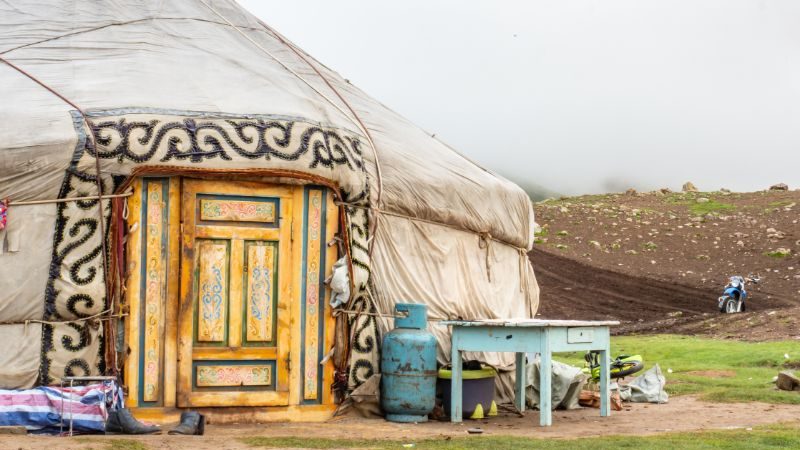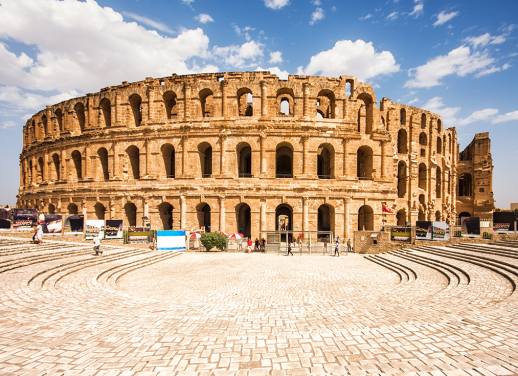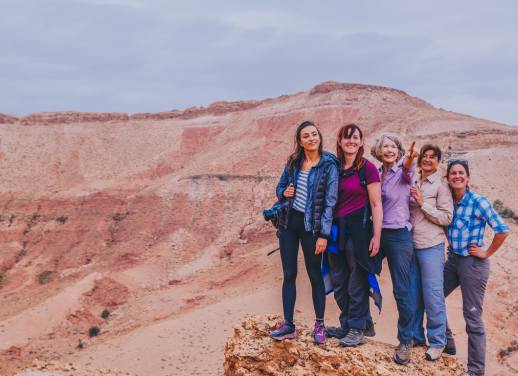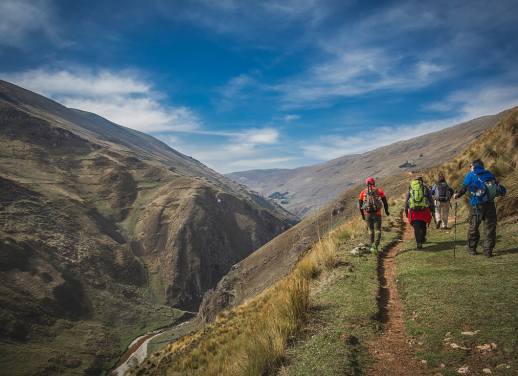Four burly Mongolian men huddle around the black, steaming vessel. Words incomprehensible to my ears are uttered under breath as glances bounce between eight intense eyes.
Then, in one fell swoop, the lid is removed. Great wafts of steam exude from the pot, culminating in fragrant swirls of smoke. One by one, hot stones are removed with tongs and placed on a shiny steel plate. The whole process resembles a medical procedure – each movement is exact, and done with the precision of a surgeon.
Dinner with a local Tuvan family
But this ain’t no operation. What I’m witnessing here is the opening scene to a memorable dinner date spent with a local Tuvan family. Along with the rest of the group on Intrepid’s first-ever Uncharted Expedition, we’ve been invited into a traditional ger in Tsagaan Gol Valley, inside western Mongolia’s Altai Tavan Bogd National Park, to experience a staple of the Mongolian culinary landscape. We trekked 20 kilometres to get here.
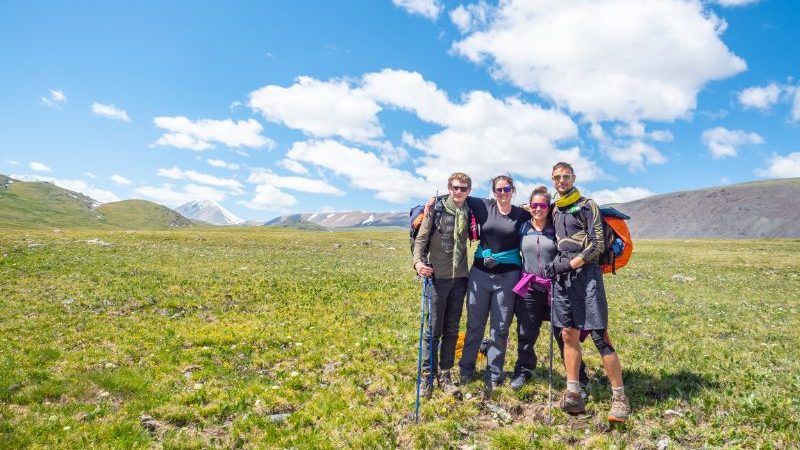
We’ve hiked 20 kms to get here!
EXPLORE OUR RANGE OF ADVENTURES THROUGH MONGOLIA HERE
Known as khorkhog, or a Mongolian barbecue, this traditional meal involves cooking pieces of meat (in this case, goat) inside a deep pot containing hot stones which are heated from the outside. It’s a laborious affair, but the results are worth it, we’re told. Meanwhile, over on the communal table, fermented mare’s milk is offered to us all, and I oblige. It’s cheesy and sour but I’m starting to get the hang of it ever since taking my first (hesitant) sip as we crossed into Mongolia from Russia at Tsagaannuur.
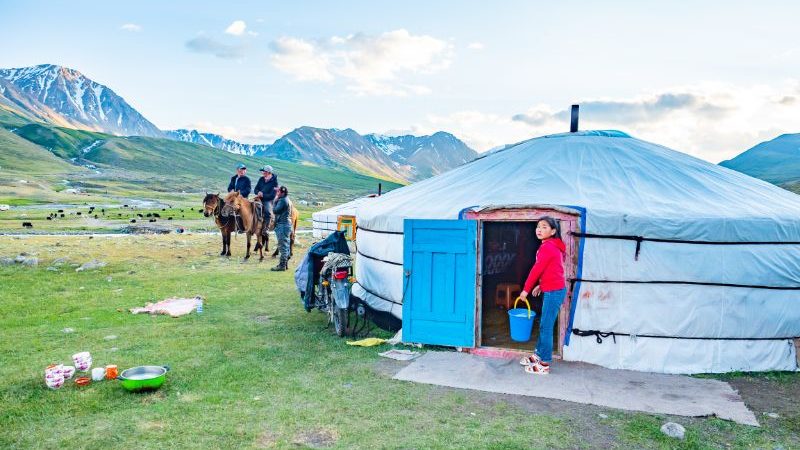
There are only around 3000 Tuvans in Mongolia.
It’s estimated that there are only around 3,000 Tuvans left in Mongolia, although their brothers and sisters in the Tuva Republic in Russia healthily boost that number up 100 fold. Like other nomads in Mongolia, Tuvans relocate seasonally as they move to newer pastures. This family has been here since June, and on average move four times a year – sometimes more if the grazing isn’t good.
INTERESTED IN AN INTREPID EXPEDITION? CHECK OUT OUR RANGE OF ADVENTURES NOW
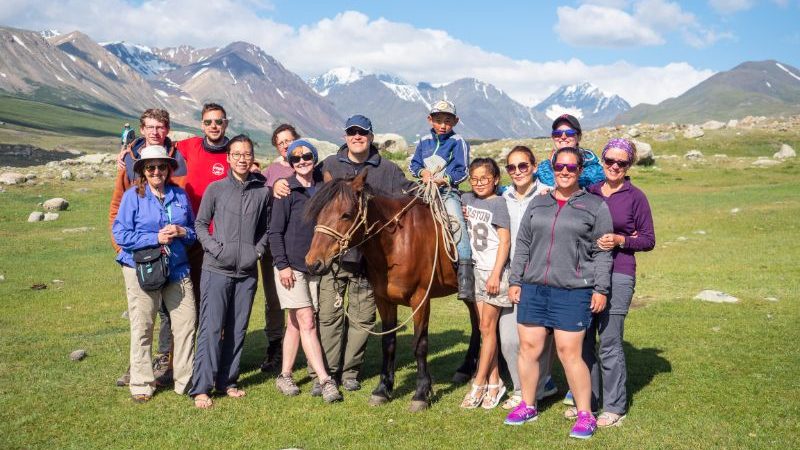
Our intrepid gang of travellers. And a horse.
“When winter hits later this year, they’ll settle in a nearby valley,” Timur, our local guide, translates for us as we feast on fatty goat alongside a seemingly endless supply of salads and sides. Winters are particularly tough here: average temperatures regularly drop below 40 degrees Celsius. Traditionally cattle-herding nomads, they tend to livestock including goats, camels, reindeer and yaks throughout the year. After tonight’s dinner, however, there will be one less goat to herd.
RELATED: VEGETARIAN? HERE’S HOW TO GET AROUND MONGOLIA WITHOUT GOING HUNGRY

This family has been here since June.
The evening passes quickly. Timur translates as questions and answers bounce between our intrepid group of 11 adventurers and the extended Tuvan family. We learn about their way of life and their traditional customs and beliefs – did you know that Tuvans, like other nomadic tribes in Mongolia, are afraid of water? We also learn that Mongolian hospitality is as legendary as its reputation. We even hear a traditional story that doesn’t seem to have an ending. Indeed, Mongolian epics are notoriously long: some literally taking an entire month to recite – no kidding.
Eventually, we retire to our tents under a starry sky. Belly full, I sink like a stone into a food coma that lasts all night.
Musical entertainment with Kazakhs
I’m sitting cross-legged inside a Kazakh ger in Ulgii, in far-western Mongolia. It’s been another long day of driving through the central plains of the country on this Uncharted Expedition, and after checking into our ger camp 15 minutes earlier, our bellies are rumbling in protest. But they won’t be for long.
Every October, thousands come to Ulgii to attend the famous Golden Eagle Festival, where the ancient tradition of eagle hunting is put on full glorious display. But we’re here for another reason. In true Mongolian hospitality, we’ve been invited over for dinner in the home of a local Kazakh family. And apparently they have a surprise for us – but we’ll have to wait until after dinner for that, we’re told.
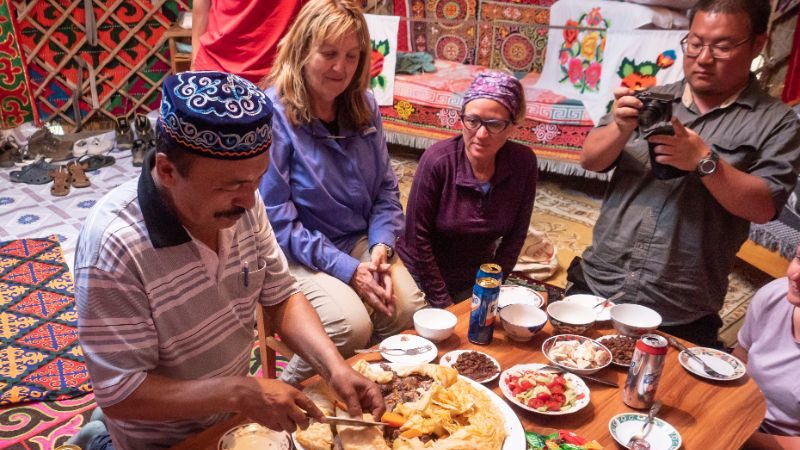
Dinner is served.
In the interim, we dine like kings. “What we’re eating here is a very popular Kazakh dish,” Timur tells us, as we eat with our hands in the traditional way. Satellites of side dishes orbit around a central platter of mutton, beef and pork on a communal table, and we all stuff ourselves silly on cucumber and tomato salad, hard cheeses (such as the white qurt, made from goat, sheep and cow’s milk), carrots and potatoes. Fermented mare’s milk, known as kumis in the local Turkic language, is used to wash it all down.
RELATED: WHAT IT’S LIKE TO ROAD TRIP THROUGH MONGOLIA
Unlike other nomadic tribes in Mongolia, who look to Buddhism and Shamanism for spiritual guidance, Kazakhs derive their spiritual comfort in Islam, which was first introduced to the region during the eighth century when Arab missionaries entered Central Asia. To this day, the Kazakh community is tightly knit, and Kazakhs are the predominant ethnic group in this part of Mongolia.
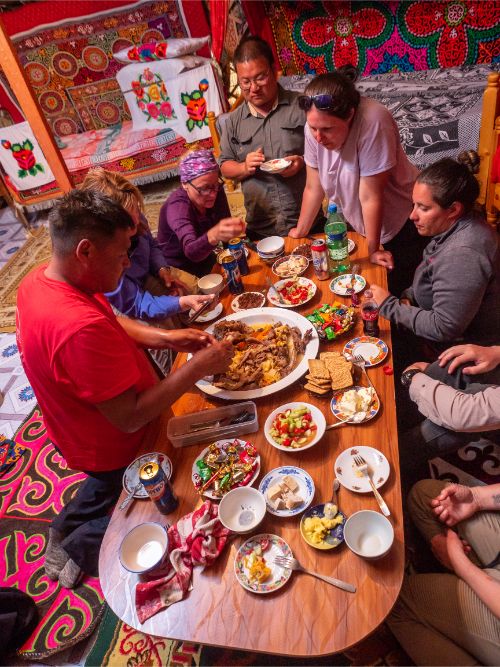
Colour is EVERYWHERE in these gers.
Besides practicing Islam, there are some other noticeable differences between the Kazakhs and other nomadic groups in Mongolia. For example, Kazakh gers are more colourfully decorated, and this ger is no exception. Richly patterned tapestries adorn walls built on a lattice skeleton frame, while colourful rugs embroidered with deep reds, vibrant yellows and hot pink cover the floor. Everywhere I look, I’m hit with an explosion of colour. “The city and the surrounding villages survive heavily on textiles,” says Anton, our trip leader who’s been with us since the start of Uncharted, all the way back in Nur Sultan, Kazakhstan. Tomorrow, we’ll visit a local artisan workshop to see how traditional Kazakh embroidery and textiles are made, before continuing on to Khovd.
But this evening is all about another art form. Turns out, the family we’re dining with is rather famous on the musical circuit. Known as the Kugyershin Family, they tour the world playing Kazakh music; they’ve even recorded their own albums. Tonight, the father of the family and his son, wielding traditional dombras, will put on a special show for us.
RELATED: HOW TO SPEND 24 HOURS IN NUR-SULTAN, KAZAKHSTAN
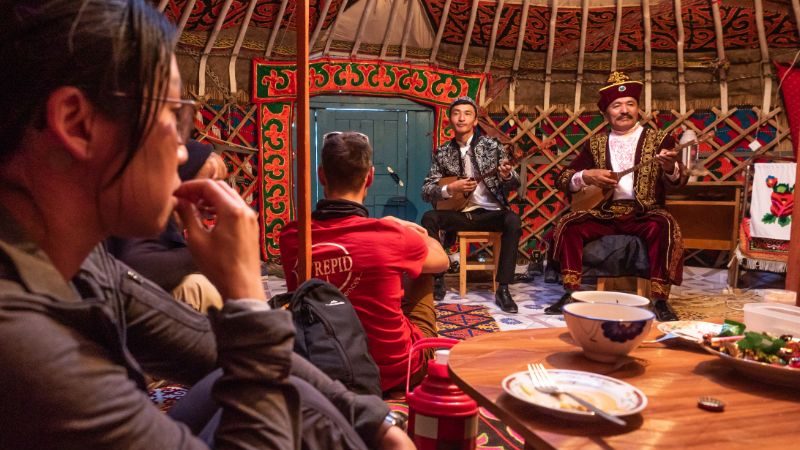
Evening entertainment.
With its long neck, the teardrop-shaped dombra resembles the lute. Made from wood, this two-stringed instrument is used as a solo or accompanying instrument. Traditionally, strings were made of sinew (sheep or goat guts); today, nylon gets plucked. It’s one of the most common traditional instruments of the Kazakh people, and plays a key role in Kazakh traditional music.
For the next 30 minutes, our group is serenaded with traditional Kazakh music. Father and son’s torsos rock and sway gently from side to side, their toes pivoting every now and then. Occasionally, bursts of quick, rhythmic strumming fill the air, as vocal lines dovetail in unison before splintering off into velvety harmonies, heavy on vibrato. It almost sounds like Hawaiian music to my ears.
It will be another long day of driving tomorrow, so we return to our ger camp satiated and elated by the night’s musical entertainment. I make a note to look at up the Kugyershin Family on Spotify when I get home – they’ve just recruited a new fan.
Lunch with the Zakhchins
One by one, we’re welcomed into the ger, smiles beaming all round. In traditional Mongolian form, we’re offered tea and told to sit down around a communal table covered with curd, cheese and candy. Wolf pelts hang from the walls, next to fading wedding photos and sports medals. It’s been a long morning of driving through the plains of Mongolia, and we’re happy to stretch our legs.
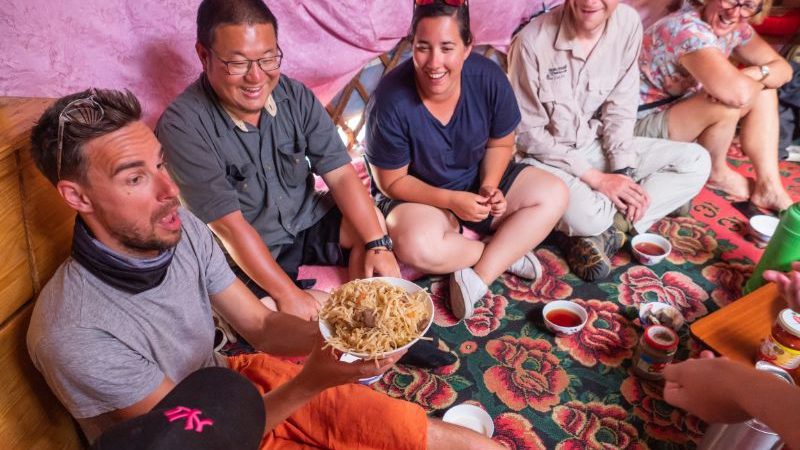
Anton, our leader, explains what we’re eating.
We’ve just arrived in Khovd, in western Mongolia. Home to more than 17 different ethnic groups, this town is known for its multi-cultural population. But today, we’ll be breaking bread with the Zakhchin, an ethnic subgroup of the Oirats who originated in the Altai mountains of Mongolia and Xinjiang in China. Like most other Mongolian tribes, the Zakhchin practice Tibetan Buddhism and Shamanism. There are just over 32,000 of them in Mongolia at present.
RELATED: 6 REASONS CENTRAL ASIA SHOULD BE ON YOUR TRAVEL RADAR
Besides learning about the family – they have five kids and one grandchild, and the father was once head of the local communist party branch for seven years – we also learn about more general aspects of Mongolian culture, such as the importance of ghee. “We put ghee in everything, even in tea. Just one teaspoon of ghee in winter can help you stay warm,” Timur explains as we’re each served a bowl of tsuivan, a traditional fried noodle dish with meat and veggies. It’s delicious and I have two bowls.
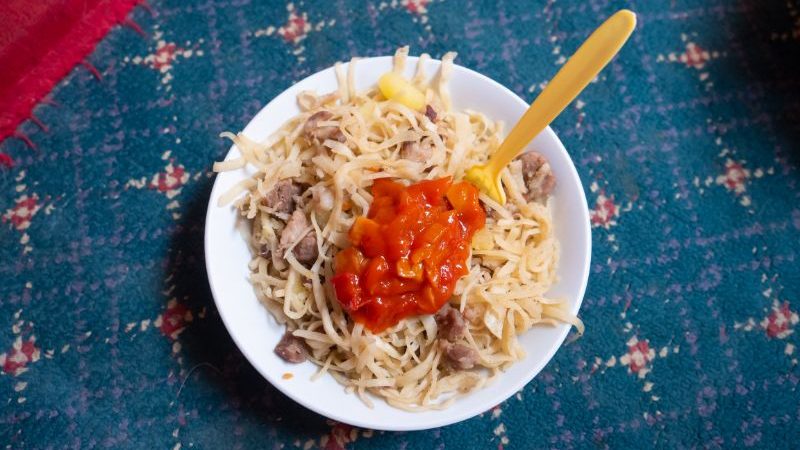
Tsuivan, a fried noodle dish.
We need to get back on the road to continue our journey to Tsenkher Cave, famous for its ancient rock paintings that are estimated to be between 15 to 40,000 years old. But not before a quick photo shoot with the family – and their horse – outside the ger. It’s a riot of laughs and gestures. Before getting back in our van, we decide to walk off lunch with a stroll through the town, past statues of Soviet war heroes, government buildings and the local school.
We part ways with the Zakhchin family after our brief city tour, once again amazed by Mongolian hospitality and the sheer diversity of its nomadic tribes.
Experience life in a nomadic ger camp on Intrepid’s 18-day small group adventure from Kazakhstan to Mongolia; (or check out our full range of trips in Mongolia here).
All photography by Shaun Busuttil.

